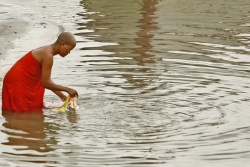Martial Arts: Scientific method
Taekwondo techniques involve mental processes but they mostly involve physical processes (movements). The scientific method should be used when dealing with physical processes. The scientific method has four steps:
- Observation and description of a phenomenon or group of phenomena.
- Formulation of a hypothesis to explain the phenomena. In physics, the hypothesis often takes the form of a causal mechanism or a mathematical relation.
- Use of the hypothesis to predict the existence of other phenomena, or to predict quantitatively the results of new observations.
- Performance of experimental tests of the predictions by several independent experimenters and properly performed experiments.
Martial artists do not need to be scientists to evaluate martial art techniques. They only need to:
- Know the basic laws of physics as they relate to martial art techniques.
- Know some basic engineering practices and be able to relate them to martial art techniques.
- Be able to evaluate martial art techniques using known data or from watching the techniques in practice.
All physical phenomena are explained by the laws of physics; therefore, martial art techniques must comply with these laws. The physics of taekwondo techniques are explained in other topics within TKDTutor.
Basic engineering practices explain the importance of position and alignment in martial art movements. The Roman used the arch in their structures because they knew of its ability to disperse loads evenly; martial arts use the strength of the arch in their stances. Builders use practices such as pre-stressing in anticipation of heavy loading; martial arts use pre-stressing when they teach you should push outward on the knees in anticipation of the knee being pressed inward by an attack, or that you should tense the body just before your punch makes contact with its target. Knowing the tensile, compressive, and bending strength of flesh and bone helps in knowing which techniques are more effective than others under certain conditions. Knowing how age affects the body's elasticity helps us understand how techniques must be changed as we age.
Scientific measurement, description, analysis, and modeling may be applied to martial art techniques and used to evaluate their effectiveness or to improve their effectiveness. This does not have to be an elaborate scientific investigation; it may just be using basic reason, logic, and common sense to analyze techniques objectively.
When describing taekwondo techniques, TKDTutor tries to objectively evaluate the techniques, pointing out the bad points as well as the good points. Sometimes, this supports the taekwondo way of doing techniques, but sometimes, it may lead to a rejection of standard taekwondo practices.

